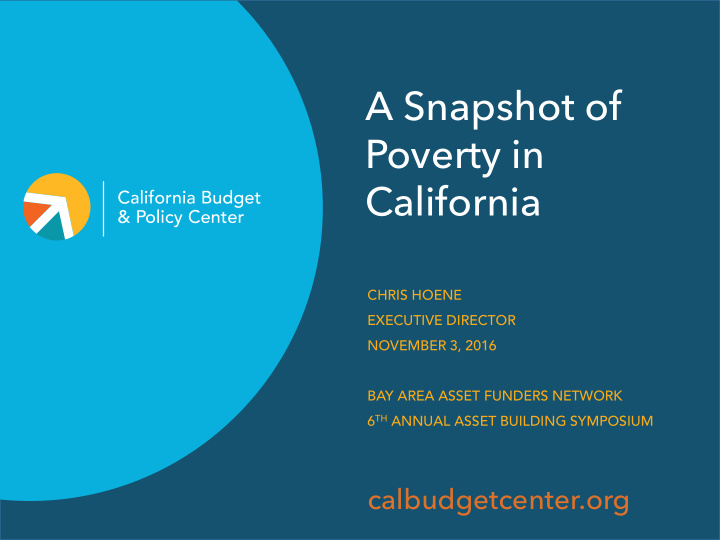



A Snapshot of Poverty in California CHRIS HOENE EXECUTIVE DIRECTOR NOVEMBER 3, 2016 BAY AREA ASSET FUNDERS NETWORK 6 TH ANNUAL ASSET BUILDING SYMPOSIUM calbudgetcenter.org
Although Poverty Declined in 2015, Many People Are Still Not Sharing in California’s Recent Economic Gains Percentage of Californians With Incomes Below the Official Federal Poverty Line 25% 23.8% Child Poverty Rate 21.2% Poverty Rate 20 17.3% 17.0% 15.3% 15 12.4% End of Great Recession 10 5 0 2006 2007 2008 2009 2010 2011 2012 2013 2014 2015 | 2 Source: US Census Bureau, American Community Survey
Economic Hardship Is More Common Across All Age Groups Under a Better Measure of Poverty Average Annual Percentage of Californians in Poverty, 2013-2015 25% 23.8% Official Poverty Measure 21.5% Supplemental Poverty 20.6% 20.3% Measure 19.5% 20 14.9% 15 13.1% 11.7% 10 5 All Ages Children Working-Age Seniors (Under 18) (18 to 64) (65 or Older) | 3 Source: Budget Center analysis of US Census Bureau, Current Population Survey data
For Most Groups, Children Are More Likely to Live in Poverty Based on a Better Measure of Hardship Average Annual Percentage of California Children in Poverty, 2013-2015 35% 33.5% 33.2% Official Poverty Measure 29.7% Supplemental Poverty 30 Measure 25.7% 25 19.4% 20 18.6% 14.8% 15 12.1% 10.6% 10.2% 10 5 Asian Black Latino White Other Note: Racial and ethnic groups are mutually exclusive. Asian, black, white, and “other” exclude children who also identify as Latino. “Other” includes Pacific Islanders, Native Americans, and children who identify with more than one race. | 4 Source: Budget Center analysis of US Census Bureau, Current Population Survey data
Public Supports Lift Many California Children Out of Poverty Each Year Average Annual Number of Children Lifted Above the Poverty Line, 2009 to 2012 800,000 600,000 400,000 200,000 Federal EITC CalFresh CalWORKs Federal Social Unemployment SSI/SSP & Child Tax Housing Security Insurance Credit Assistance Note: This analysis is based on the US Census Bureau’s Supplemental Poverty Measure after correcting for underreported public supports using US Department of Health and Human Services data and the Urban Institute TRIM model. | 5 Source: Center on Budget and Policy Priorities
Poverty Rates Remain High in Many Parts of the State, Even in Places Where Job Gains Have Been Strong Percentage-Point Difference in Official Federal Poverty Rate Between 2007 and 2015 More Than 8.0 Percentage Points Higher 4.1 to 8.0 Percentage Points Higher Up to 4.0 Percentage Points Higher No Statistically Significant Difference No Data Available | 6 Source: Budget Center analysis of US Census Bureau, American Community Survey data
State of the State: Policies to Foster Economic Opportunity in California | 7
1107 9th Street, Suite 310 Sacramento, California 95814 916.444.0500 choene@calbudgetcenter.org @ChrisWHoene @CalBudgetCenter calbudgetcenter.org
Recommend
More recommend